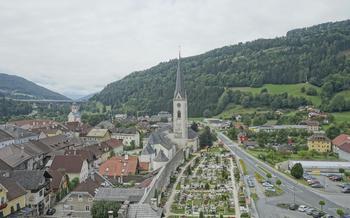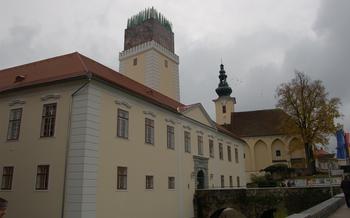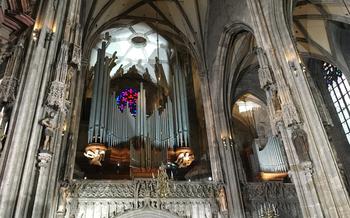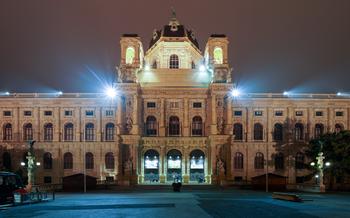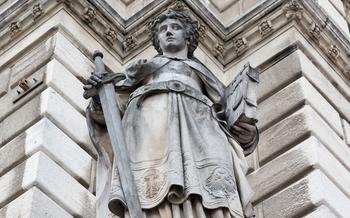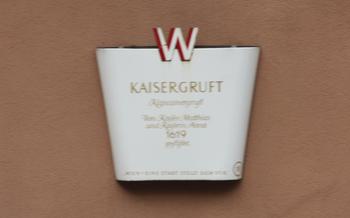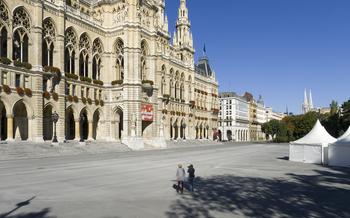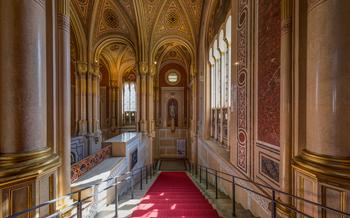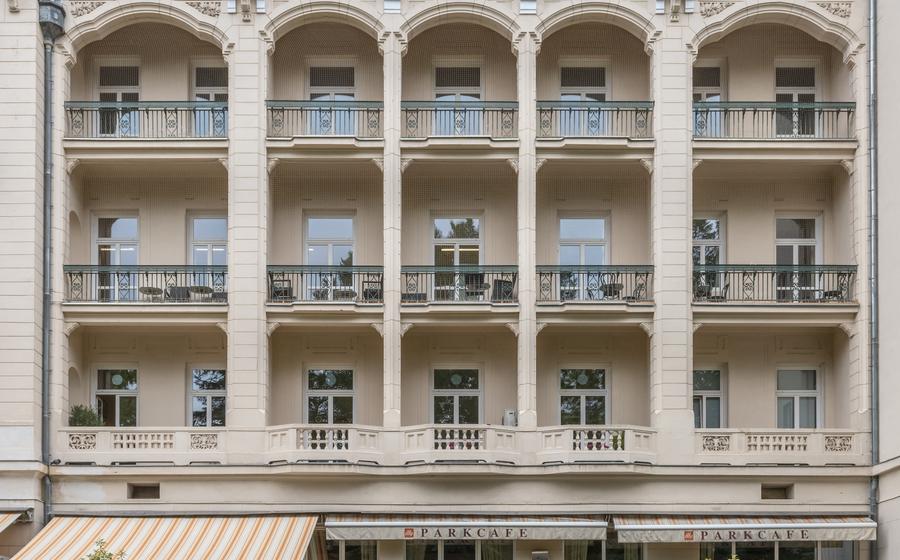
Auer von Welsbach Museum in Althofen
- Auer von Welsbach Museum: A Legacy of Innovation
- The Genius Behind the Light: Carl Auer von Welsbach
- The Museum's Collection: A Treasure Trove of Discoveries
- Immersive Experience: Exploring the World of Science
- Architectural Marvel: A Building Steeped in History
- Local Legends and Anecdotes: Uncovering the Human Side
- Interactive Exhibits: A Journey Through Time
- Workshops and Demonstrations: Hands-On Learning
- Thematic Exhibitions: Exploring Special Topics
- Educational Programs: Nurturing Young Minds
- Community Events: A Gathering Place for Science Enthusiasts
- Souvenirs and Publications: Mementos of a Visit
- Research and Scholarship: A Center of Academic Excellence
- Accessibility and Facilities: Ensuring Inclusivity
- Insider Tip: Hidden Gems of the Museum
Auer von Welsbach Museum: A Legacy of Innovation
The Auer von Welsbach Museum in Althofen, Austria, is a treasure trove of scientific discoveries and technological marvels. Dedicated to the life and work of Carl Auer von Welsbach, one of the most influential scientists of the 19th century, this museum offers a fascinating journey through the history of lighting technology and beyond. Located in the heart of Althofen, a charming town steeped in history, the museum is easily accessible by public transportation or car. Its stunning Renaissance-style building, once a castle, adds to the allure of this extraordinary destination.
Inside, visitors are greeted by a diverse collection of exhibits that showcase Auer von Welsbach's groundbreaking contributions to science. From his early experiments with rare earth elements to his invention of the incandescent gas mantle, which revolutionized lighting technology, the museum provides a comprehensive overview of his remarkable achievements. Interactive displays, multimedia presentations, and hands-on activities bring his discoveries to life, making learning an immersive and engaging experience for visitors of all ages.
The Genius Behind the Light: Carl Auer von Welsbach
Carl Auer von Welsbach, born in Vienna in 1858, was a remarkable figure whose contributions to science and technology have left an enduring legacy. His insatiable curiosity and brilliant mind led him to pursue a diverse range of fields, from chemistry and physics to botany and geology.
Auer von Welsbach's early education laid the foundation for his future achievements. He attended the prestigious Vienna University of Technology, where he excelled in his studies and developed a deep fascination for the natural world. His thirst for knowledge and experimentation soon propelled him to the forefront of scientific research.
Among Auer von Welsbach's most notable contributions is his invention of the incandescent gas mantle, a breakthrough that revolutionized lighting technology. By impregnating a fabric mesh with rare earth elements and heating it to incandescence, he created a light source that was far brighter and more efficient than the traditional gas burners of the time. This invention had a profound impact on urban lighting, bringing brighter and safer streets to cities around the world.
Auer von Welsbach's work extended beyond the field of lighting. He also made significant contributions to the development of the Nernst lamp, an early form of electric lighting, and conducted groundbreaking research on the chemistry of rare earth elements. His tireless pursuit of knowledge and his ability to bridge different scientific disciplines earned him international recognition and numerous awards.
The Museum's Collection: A Treasure Trove of Discoveries
The Auer von Welsbach Museum houses an extensive collection of artifacts, documents, and interactive exhibits that offer a comprehensive insight into the life and work of Carl Auer von Welsbach. Among the highlights of the collection are:
-
Rare Artifacts: The museum showcases a range of artifacts related to Auer von Welsbach's research and inventions, including his original laboratory equipment, personal belongings, and prototypes of his groundbreaking lighting devices.
-
Documents and Letters: Visitors can peruse a collection of letters, manuscripts, and other documents that shed light on Auer von Welsbach's scientific correspondence, collaborations, and thought processes.
-
Interactive Exhibits: The museum features interactive exhibits that bring Auer von Welsbach's experiments and discoveries to life. Visitors can engage with hands-on displays, multimedia presentations, and virtual reality experiences that illustrate the principles behind his inventions.
These exhibits provide a unique opportunity to delve into the mind of a scientific pioneer and gain a deeper understanding of the history of lighting technology and its impact on our modern world.
Immersive Experience: Exploring the World of Science
The Auer von Welsbach Museum offers an immersive experience that brings the world of science to life. Guided tours led by knowledgeable docents provide visitors of all ages with an engaging and informative journey through the museum's exhibits. Educational programs tailored to different grade levels make learning about science and history fun and interactive for school groups.
Hands-on activities allow visitors to engage with scientific concepts in a practical way. From experimenting with different lighting technologies to building their own simple machines, these activities provide a deeper understanding of the principles behind Auer von Welsbach's inventions. Visitors can also participate in workshops and demonstrations that showcase the practical applications of science and technology, making the museum a truly interactive and immersive experience.
Architectural Marvel: A Building Steeped in History
The Auer von Welsbach Museum is housed in a magnificent Renaissance-style building that is a testament to the region's rich cultural heritage. Constructed in the 16th century, the building was originally a castle, reflecting the historical significance of the site. Its imposing facade, adorned with intricate carvings and decorative elements, hints at the treasures that lie within.
The museum's location in the heart of Althofen, a charming town known for its well-preserved medieval architecture, further enhances its historical significance. The building's connection to Auer von Welsbach himself adds another layer of intrigue, as it was once owned by his family.
Stepping inside the museum, visitors are greeted by a grand entrance hall that sets the tone for the journey they are about to embark on. The building's interior has been carefully restored to retain its original character, while incorporating modern amenities to ensure a comfortable and engaging experience for visitors.
Throughout the museum, visitors can admire architectural details that speak to the building's rich history. From the intricate frescoes that adorn the walls to the vaulted ceilings that soar overhead, each element contributes to the overall grandeur of the space.
The Auer von Welsbach Museum is not just a repository of scientific discoveries; it is also a testament to the region's architectural heritage. The building itself is a work of art, inviting visitors to explore the fascinating interplay between science, history, and culture.
Local Legends and Anecdotes: Uncovering the Human Side
Beyond his scientific achievements, Carl Auer von Welsbach was a man of remarkable character and eccentricities. Local legends and anecdotes paint a vivid picture of his personality and the cultural context of his time. One story recounts his fascination with the night sky, leading him to construct a small observatory in his garden. Another tale speaks of his generosity, as he would often anonymously donate large sums of money to support local charities and individuals in need.
A humorous anecdote tells of Auer von Welsbach's absent-mindedness. Once, while engrossed in his experiments, he accidentally set fire to his laboratory. Instead of panicking, he calmly remarked, "Well, at least now I know that my invention works!" These stories offer a glimpse into the human side of a brilliant scientist, showcasing his quirks, passions, and dedication to his craft.
Interactive Exhibits: A Journey Through Time
The Auer von Welsbach Museum brings history to life with an array of interactive exhibits that transport visitors to the past and allow them to explore scientific concepts firsthand. Through multimedia presentations, virtual reality experiences, and interactive displays, visitors can immerse themselves in the world of science and innovation.
Multimedia presentations showcase Auer von Welsbach's discoveries, providing visitors with a deeper understanding of his groundbreaking work. Virtual reality experiences take visitors on a journey through time, allowing them to witness the invention of the incandescent gas mantle and experience the impact of Auer von Welsbach's innovations.
Interactive displays offer a hands-on approach to learning, inviting visitors to engage with scientific concepts and explore the principles behind Auer von Welsbach's inventions. These interactive exhibits make science accessible and engaging, fostering a love of learning and scientific inquiry.
With its immersive exhibits and interactive experiences, the Auer von Welsbach Museum offers visitors a unique opportunity to explore the world of science and innovation, gaining a deeper appreciation for the legacy of this brilliant inventor.
Workshops and Demonstrations: Hands-On Learning
The Auer von Welsbach Museum offers a range of hands-on workshops and live demonstrations that bring science and technology to life. These interactive experiences allow visitors to engage with Auer von Welsbach's groundbreaking work in a practical and immersive way.
In the workshops, participants can get involved in activities such as building their own simple light sources, experimenting with different lighting technologies, and exploring the principles of optics. These hands-on sessions provide a deeper understanding of the scientific concepts behind Auer von Welsbach's inventions and their impact on our daily lives.
Live demonstrations showcase the principles behind Auer von Welsbach's inventions in a captivating and engaging manner. Visitors can witness the mesmerizing process of gas mantle production, marvel at the brilliant glow of incandescent gas lighting, and learn about the intricate workings of early lighting devices. These demonstrations offer a unique opportunity to see science in action and gain a deeper appreciation for the ingenuity and creativity of Auer von Welsbach.
Through these interactive workshops and demonstrations, the Auer von Welsbach Museum provides visitors with a hands-on learning experience that fosters a deeper understanding of science, technology, and the legacy of one of Austria's most renowned inventors.
Thematic Exhibitions: Exploring Special Topics
The Auer von Welsbach Museum goes beyond showcasing the life and work of its namesake. It also hosts temporary exhibitions that delve into specific aspects of his research, scientific discoveries, and their impact on society. These exhibitions are curated in collaboration with other institutions, allowing for a broader exploration of related scientific and historical themes.
One of the highlights of these thematic exhibitions is the opportunity for visitors to gain deeper insights into Auer von Welsbach's scientific process, including his failures and challenges. The exhibitions often feature rare artifacts, documents, and interactive displays that bring these stories to life. Visitors can trace the evolution of his ideas, from initial hypotheses to groundbreaking discoveries.
Another focus of the thematic exhibitions is to explore the broader impact of Auer von Welsbach's work on society and technology. His inventions and discoveries, particularly in the field of lighting, had far-reaching consequences for everyday life. The exhibitions examine how his innovations shaped industries, transformed urban landscapes, and improved living conditions for people worldwide.
By organizing thematic exhibitions, the Auer von Welsbach Museum strives to create a dynamic and evolving experience for visitors. These exhibitions offer a platform to explore new perspectives, gain a deeper understanding of scientific advancements, and appreciate the enduring legacy of Carl Auer von Welsbach.
Educational Programs: Nurturing Young Minds
The Auer von Welsbach Museum recognizes the importance of fostering a love of learning and scientific inquiry among the younger generation. To this end, the museum offers a range of educational programs and resources designed to engage and inspire students of all ages.
School programs are a key component of the museum's educational outreach. These programs bring science and history to life for students, allowing them to explore Auer von Welsbach's work and its impact on the world. Through interactive activities, hands-on experiments, and guided tours, students gain a deeper understanding of scientific concepts and the history of innovation.
The museum also provides educational resources for teachers to incorporate into their curriculum. These resources include lesson plans, activity sheets, and multimedia presentations that align with educational standards and learning objectives. By utilizing these resources, teachers can create engaging and informative lessons that bring science and history to life in the classroom.
The Auer von Welsbach Museum is committed to nurturing young minds and cultivating a passion for science and technology. Through its educational programs and resources, the museum plays a vital role in inspiring the next generation of innovators and thinkers.
Community Events: A Gathering Place for Science Enthusiasts
The Auer von Welsbach Museum serves as a vibrant hub for scientific discourse and community engagement through its regular events, workshops, and lectures. These events bring together individuals passionate about science, history, and innovation to explore various topics related to Auer von Welsbach's work and the broader scientific landscape.
Visitors have the opportunity to interact with renowned scientists, historians, and educators, gaining insights into the latest scientific discoveries and the historical context of Auer von Welsbach's era. These events foster a sense of community among science enthusiasts, providing a platform for sharing knowledge, exchanging ideas, and sparking new collaborations.
Whether it's a workshop on hands-on scientific experiments, a lecture on the history of lighting technology, or a panel discussion on current scientific advancements, the Auer von Welsbach Museum offers a diverse range of events that cater to all interests. These events not only educate and entertain but also inspire a deeper appreciation for the wonders of science and innovation.
So, if you're looking to immerse yourself in the world of science and connect with like-minded individuals, be sure to check out the Auer von Welsbach Museum's upcoming events. These events offer a unique opportunity to engage with experts, explore new ideas, and become part of a vibrant community of science enthusiasts.
Souvenirs and Publications: Mementos of a Visit
The Auer von Welsbach Museum offers a well-stocked museum shop where visitors can purchase a variety of souvenirs and publications to commemorate their visit and delve deeper into the life and work of Carl Auer von Welsbach. The shop features a carefully curated selection of books, including biographies, scientific texts, and historical accounts that provide comprehensive insights into Auer von Welsbach's contributions to science and technology.
Visitors can also find an array of souvenirs, such as postcards, magnets, and keychains adorned with images of Auer von Welsbach's inventions and the museum's historic building. These souvenirs serve as tangible reminders of the museum's legacy and make for unique gifts for friends and family.
For those seeking a deeper understanding of Auer von Welsbach's work, the museum shop offers a range of publications, including scientific papers, research articles, and exhibition catalogs. These publications provide detailed accounts of Auer von Welsbach's experiments, discoveries, and the impact of his inventions on the development of lighting technology.
Whether you're a casual visitor or a passionate science enthusiast, the museum shop at the Auer von Welsbach Museum offers something for everyone. Take home a piece of the museum's legacy and continue your journey of scientific exploration.
Research and Scholarship: A Center of Academic Excellence
The Auer von Welsbach Museum is not only a place of public education and engagement but also a center of academic excellence. The museum collaborates closely with universities and research institutions to promote ongoing study and research on Auer von Welsbach's work and its broader implications for science and technology. Scholars and researchers have access to the museum's extensive archives, which house a wealth of primary sources, including Auer von Welsbach's personal papers, laboratory notebooks, and correspondence. Through these collaborations and research opportunities, the museum contributes to the advancement of scientific knowledge and fosters a deeper understanding of Auer von Welsbach's groundbreaking contributions.
Accessibility and Facilities: Ensuring Inclusivity
The Auer von Welsbach Museum is committed to providing an inclusive and accessible experience for all visitors. Wheelchair ramps and elevators ensure that the museum is fully accessible to visitors with disabilities. Multilingual signage and audio guides are available for international visitors, making the museum's exhibits accessible to people from all over the world. The museum staff is also trained to assist visitors with any special needs, ensuring that everyone can enjoy their visit to the fullest.
Insider Tip: Hidden Gems of the Museum
Beyond the main exhibits, the Auer von Welsbach Museum holds hidden treasures that offer unique insights into the life and work of this scientific pioneer. One such gem is a small, unassuming room tucked away in a corner of the museum. Here, visitors can marvel at a collection of personal items that belonged to Auer von Welsbach, including his writing desk, his favorite armchair, and even his smoking pipe. These artifacts provide a glimpse into his daily life and the environment in which his groundbreaking ideas took shape.
Another hidden gem is a secret garden located behind the museum building. This tranquil oasis invites visitors to take a break from their exploration and soak in the beauty of nature. Here, they can find a bust of Auer von Welsbach, surrounded by lush greenery and colorful flowers, a fitting tribute to a man whose work brought light to the world.
To make the most of your visit, plan your trip to coincide with one of the museum's special events or workshops. These events offer a unique opportunity to engage with experts in the field, participate in hands-on activities, and delve deeper into the fascinating world of science and innovation.
Finally, don't forget to visit the museum's gift shop, which offers a treasure trove of souvenirs and publications related to Auer von Welsbach and his work. From books and postcards to replica gas mantles, you're sure to find something to commemorate your visit and take a piece of the museum's legacy home with you.
